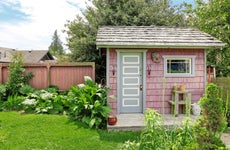How to finance aging-in-place renovations: Making your space accessible

The Bankrate promise
At Bankrate we strive to help you make smarter financial decisions. While we adhere to strict , this post may contain references to products from our partners. Here's an explanation for .
Key takeaways
- For those wanting to grow older in their own homes, HELOCs (home equity lines of credit), home improvement loans and home equity loans may be a good way to finance the necessary renovations.
- If you're moving in with a loved one, consider a personal loan or low-interest credit card to finance accessibility renovations and aids.
- FHA Loans, like Title 1 Property Improvement Loans and 203(k) loans, are often less expensive than other loans and have lower credit minimums.
In a recent Bankrate survey, 69 percent of homeowners said that — if given the choice — they would still buy their current home and go through the whole process all over again. And that sentiment only grows with age.
Staying in your own home as you grow older offers many benefits. For most, it means a stronger sense of safety, comfort and independence, and it also affords you more privacy. It can also be cheaper than the costs of an assisted living facility. To be able to age in place, you may need to make physical changes to your home and it’s best to begin planning these renovations early because the costs can be high.
How to finance home renovations for accessibility
There are a few additions we can incorporate into our homes to improve our quality of life as we age. Some can be as simple as installing sensor lighting around the house or replacing doorknobs with lever handles, but others may require help from a professional. For example, replacing your current countertop for a higher one, smoothing out floors or adding a walk-in tub. The complexity of these, inherently makes them more expensive.
A recent Bankrate survey found that about a quarter of homeowners (25 percent), have delayed some much-needed home renovations due to the current state of the economy.
Most people reach their peak earning years in their mid-40s through their mid-50s. If you’re in that sweet spot, your credit score may be the highest it’s ever been, and you also may have the most equity in your home. If that’s the case and you need help financing aging-in-place renovations, then your two best options are home improvement loans and home equity loans.
Home improvement loans
Home improvement loans are personal loans taken out specifically for funding home renovations. These loans are unsecured and rely entirely on your credit score and credit history. You won’t have to tap into your home’s equity, nor put your home at risk. But since home improvement loans are unsecured, interest rates are generally higher than those of home equity products.
Home equity loans and HELOCs
Home equity loans and HELOCs, on the other hand, turn your home’s available equity into cash, which you can then use toward renovations or whatever other expenses you’re dealing with. Since these loans are secured by your home, the interest rates should be lower than those of home improvement or personal loans.
Home improvement loans work best for short-term expenses and small amounts you know you can repay quickly because repayment periods are usually anywhere from one to 10 years. Home equity loans and HELOCs usually come with repayment periods of anywhere from 15 to 30 years. If you are unsure if you will continue to live in your home past retirement, we recommend a home improvement loan.
Keep in mind: If you are unsure if you will continue to live in your home past retirement, we recommend a home improvement loan.
Best financing options for individual situations
The situation you are in will usually determine which type of home improvement loan funding option will work best for you.
Factor-in prices for the renovations and get multiple quotes to make sure you are competitively pricing what you need. Talk to a financial professional to make sure you are also factoring in your savings, investments, and refinance options, among others, to find an efficient plan that meets your needs.— Steve Oniya | President and Chartered Financial Consultant, OM Investments
I’m still employed and haven’t retired yet
- Best for you: Home improvement loan or home equity loan or HELOC.
In a 2023 Bankrate survey, 56 percent of Americans said they feel behind on where they are with retirement savings. Meanwhile, another survey found that for 21 percent of U.S. adults, their biggest financial regret is not starting to save for retirement earlier.
If you’re still employed but considering aging in place, now’s the time to start planning. If you own a home, you’ll want to start making the property more accessible as soon as possible.
Ideally, you can spread your renovations out over time to reduce the costs and hassle. But depending on your age and retirement timeline, you might need to do several renovations at once to ensure that your property is ready.
I’m retired and on a fixed income
- Best for you: Home equity loan or HELOC, government assistance or reverse mortgage.
If you’re like many retirees, Social Security might be your only source of steady income. Though this could make it difficult to fund your necessary accessibility improvements, finding funding is not impossible.
Your best option may be to utilize the equity you’ve built up in your property or consider a reverse mortgage, also called a home equity conversion mortgage. A reverse mortgage is a type of loan that gives you money from your home equity in either a lump sum or regular monthly payments.
If you choose to tap into your home’s equity, make sure that you plan to remain in your home for at least another decade. Home equity loans and HELOCs have an average lifespan of 15 to 30 years, and a reverse mortgage will come due when the borrower either passes away, sells the home or permanently moves out.
You may also consider an FHA-backed improvement loan, like a Title 1 Property Improvement Loans or a 203(k) loan. Because each loan is insured by the federal government, you’ll likely get a lower rate than you would on other improvement loans or personal loans.
Another option is to apply for a government or state grant. Some agencies, such as the U.S. Department of Housing and Urban Development, offer grants specifically for seniors to cover some of the costs associated with aging-in-place renovations.
To be eligible for these, you’ll need to meet certain income and age requirements. This makes them a bit more restrictive than other sources of financing. That said, it’s still worth a shot, as this is money that doesn’t have to be repaid.
I’m moving in with a family member
- Best for you: Proceeds from your home sale, personal loan or low-interest credit card.
- Best for your loved one: Home equity loan or HELOC.
Moving in with a family member or loved one may mean that you have fewer options for customizing your living space. To start, talk with your loved one about potential renovations to make the property safer and more accessible.
Naturally, you’ll want to help your loved one pay for these renovations or cover them in full. If you’re selling your home before move-in, the sale proceeds can go toward any renovation costs you might encounter. If you’re not selling a property, you may consider a personal loan or a low-interest credit card to cover the costs.
If you’re on the other end of the equation — and an aging loved one is moving into your existing home — then carefully consider the space in which they’ll live. If you don’t have a dedicated room they can stay in, then you might consider adding a mother-in-law suite or accessory dwelling unit on the property.
If you do have an available room, make an effort to improve its accessibility before your loved one moves in. The small changes above are a great place to start, as are updates to the bathroom they’ll be using.
A home equity loan can help you cover the costs of these improvements, as well as any your loved one may require later as they age. You may also consider a home equity line of credit, depending on your financial situation.
Frequently asked questions
-
Even though you may still be employed, if you’re contemplating aging in place and are reaching retirement, it’s a good idea to start planning. If you’re a homeowner it can be easier on your budget to spread needed renovations over time.
-
If you’ve already retired and your budget is limited, one of the best options to pay for renovations may be tapping into the equity in your home via a home equity loan or home equity line of credit. You might also consider a reverse mortgage, which is also known as a home equity conversion mortgage. Reverse mortgages are a type of loan that provides cash from your home’s equity either via a single payment or through ongoing monthly payments.
If none of these are an option, or if you’d simply prefer not to use your equity for these renovations, you can look into government grants. Unlike loans, these are a form of aid that doesn’t need to be repaid, however, they may be harder to qualify for, as there are age and income restrictions. -
Yes, even if you anticipate moving in with a family member or loved one, their home may still require some modifications to accommodate your needs later in life. However, living with someone else may mean you have fewer options for renovations or customization.
It’s important to talk with your loved one or family member well in advance about any changes that may be needed to make the home safer and more accessible to determine what might be done, how much it will cost and how the expenses will be paid.
Because of this, it’s best to weigh all your housing options to determine whether this is the right move for you and your loved ones. In some cases, downsizing could be a better choice.
Related Articles

How to make debt work for you: Build wealth with a personal loan


How to finance a garage or other outbuilding (and why you should)
